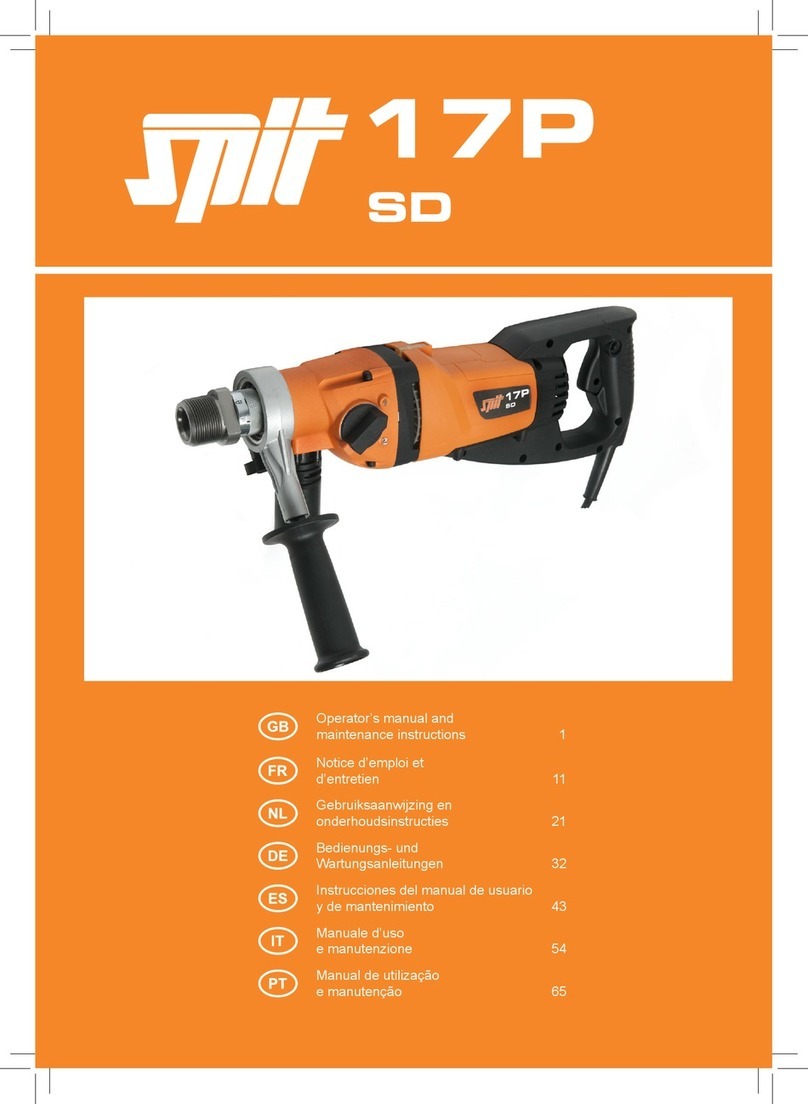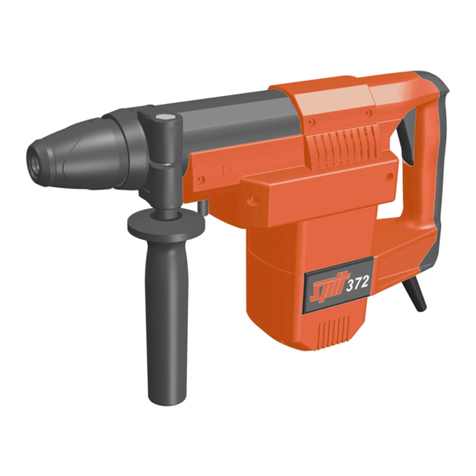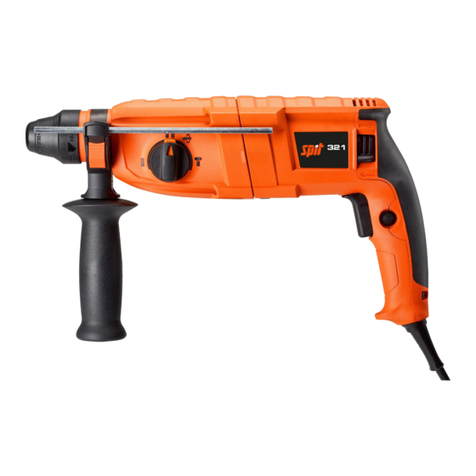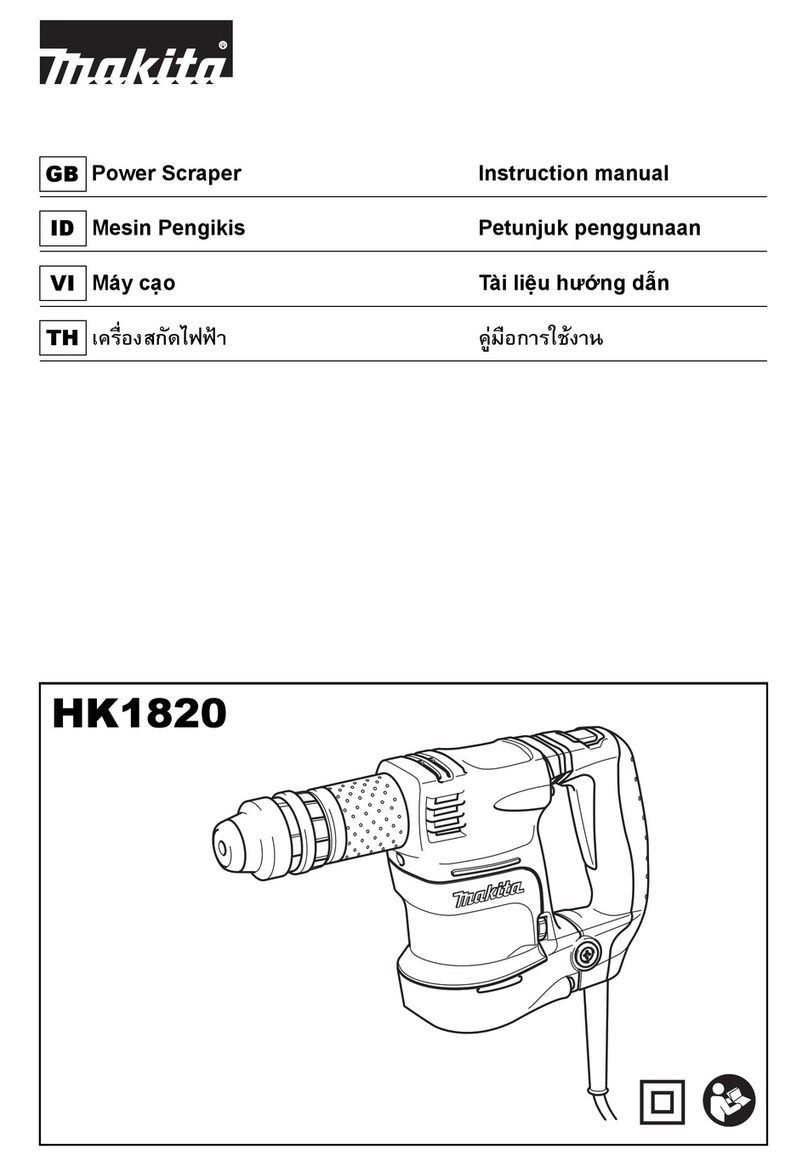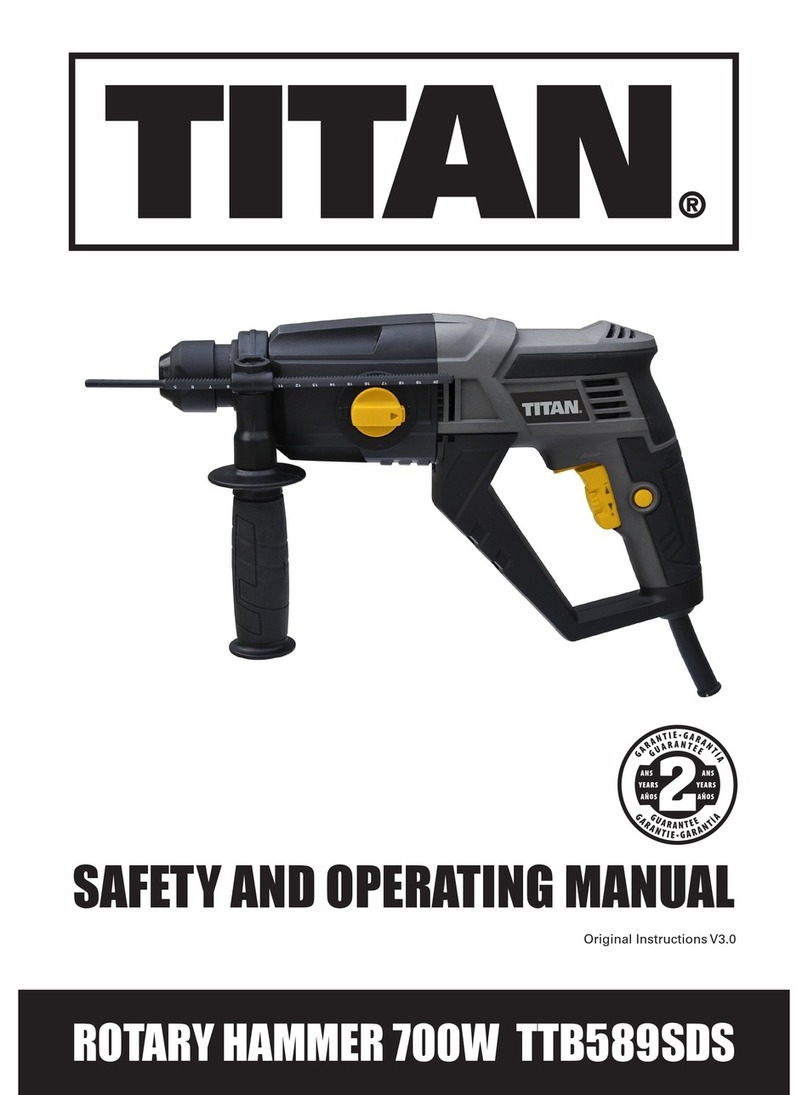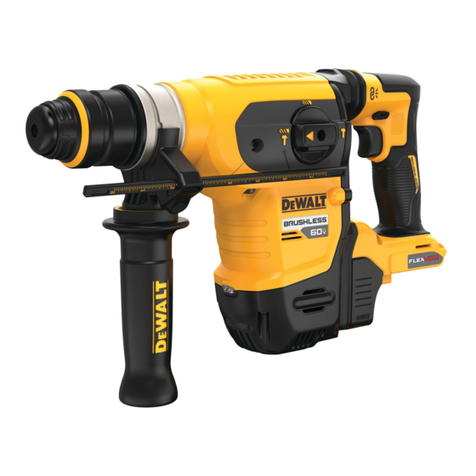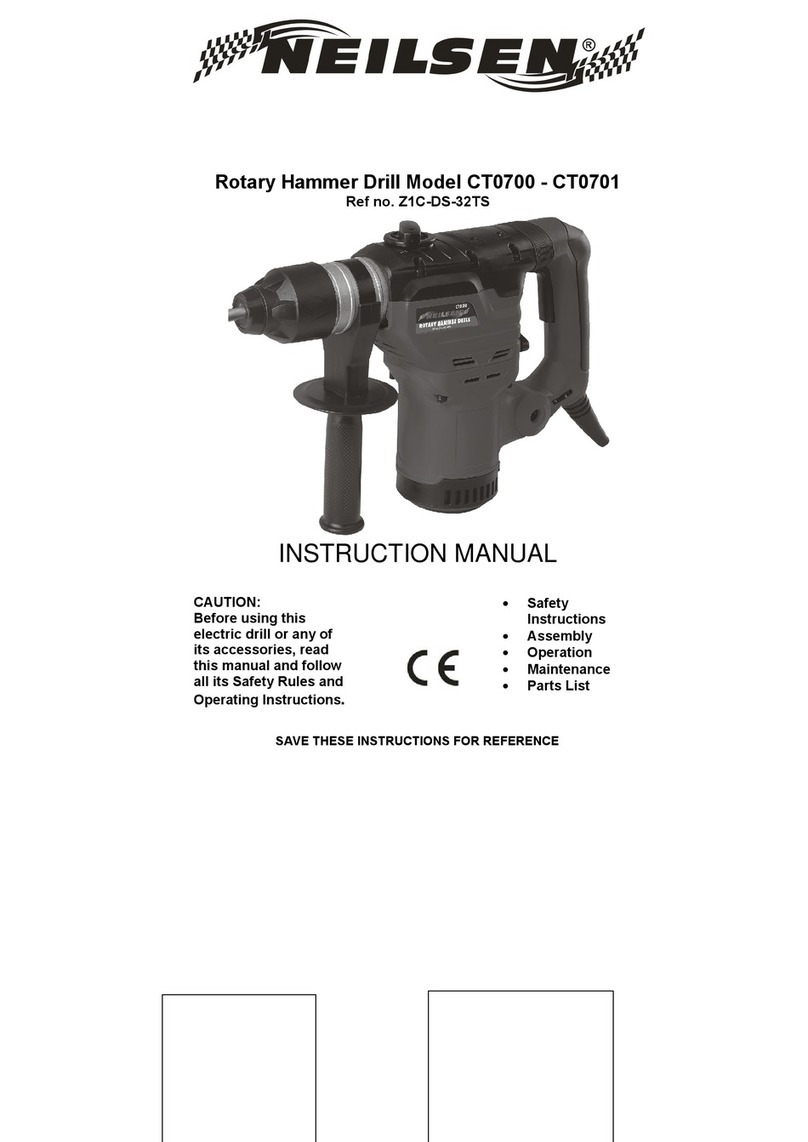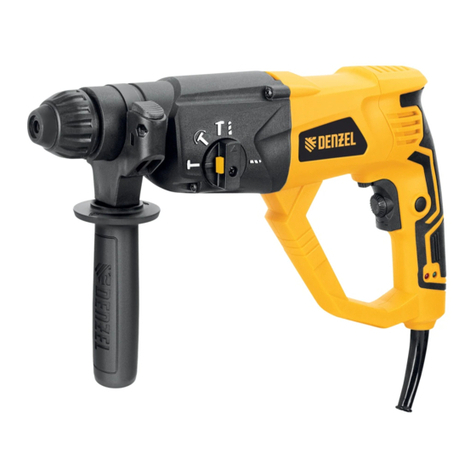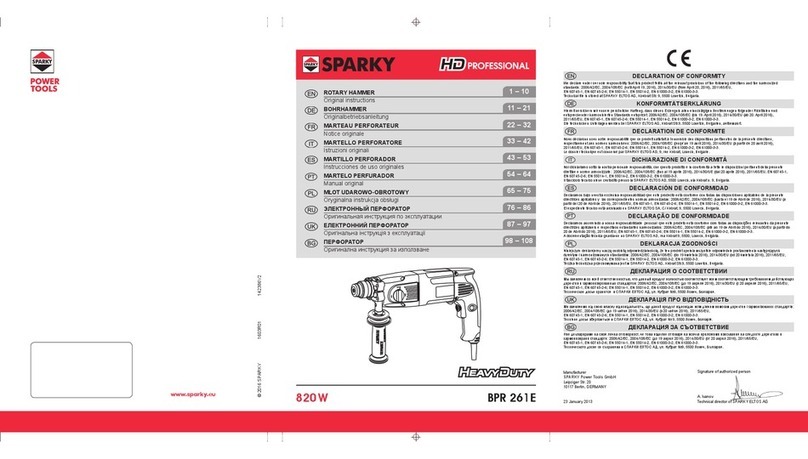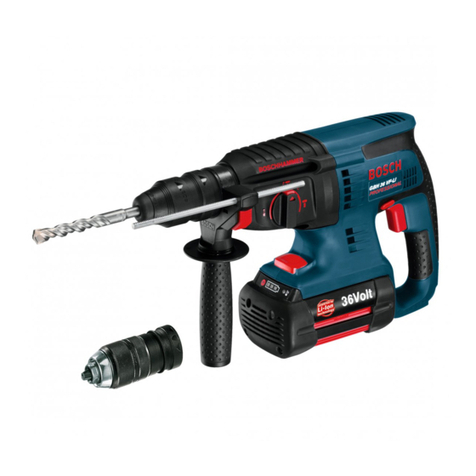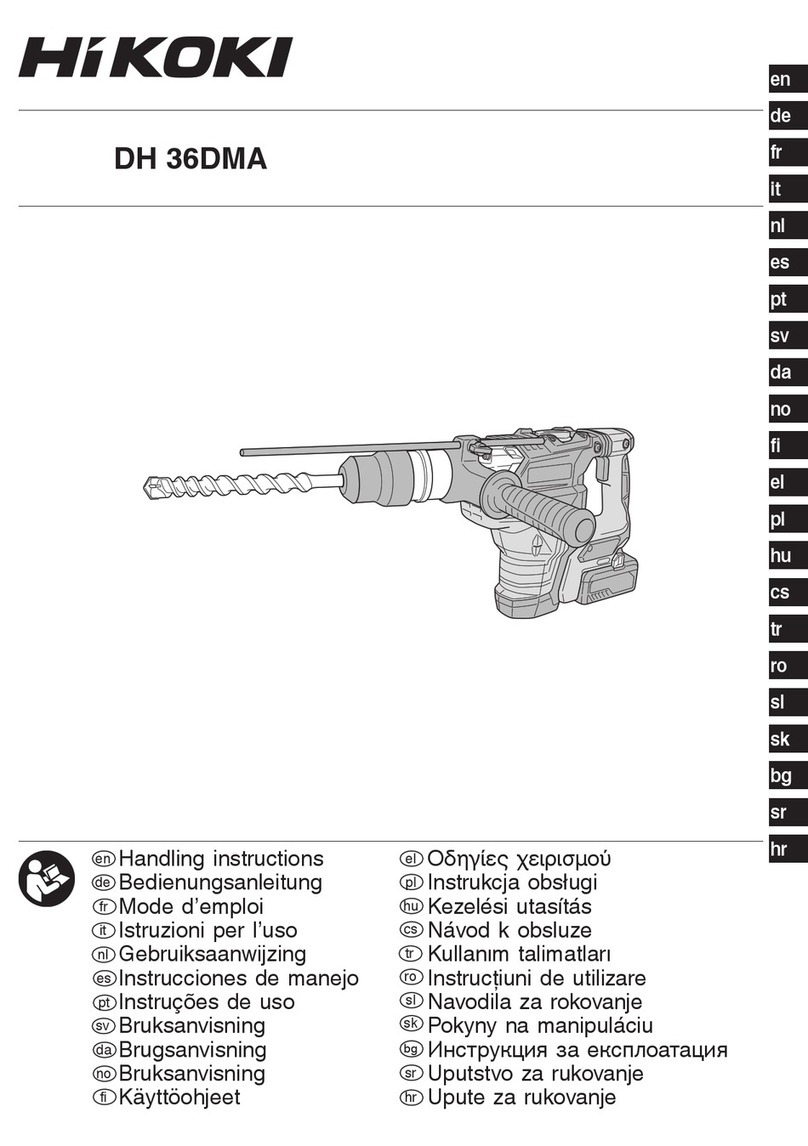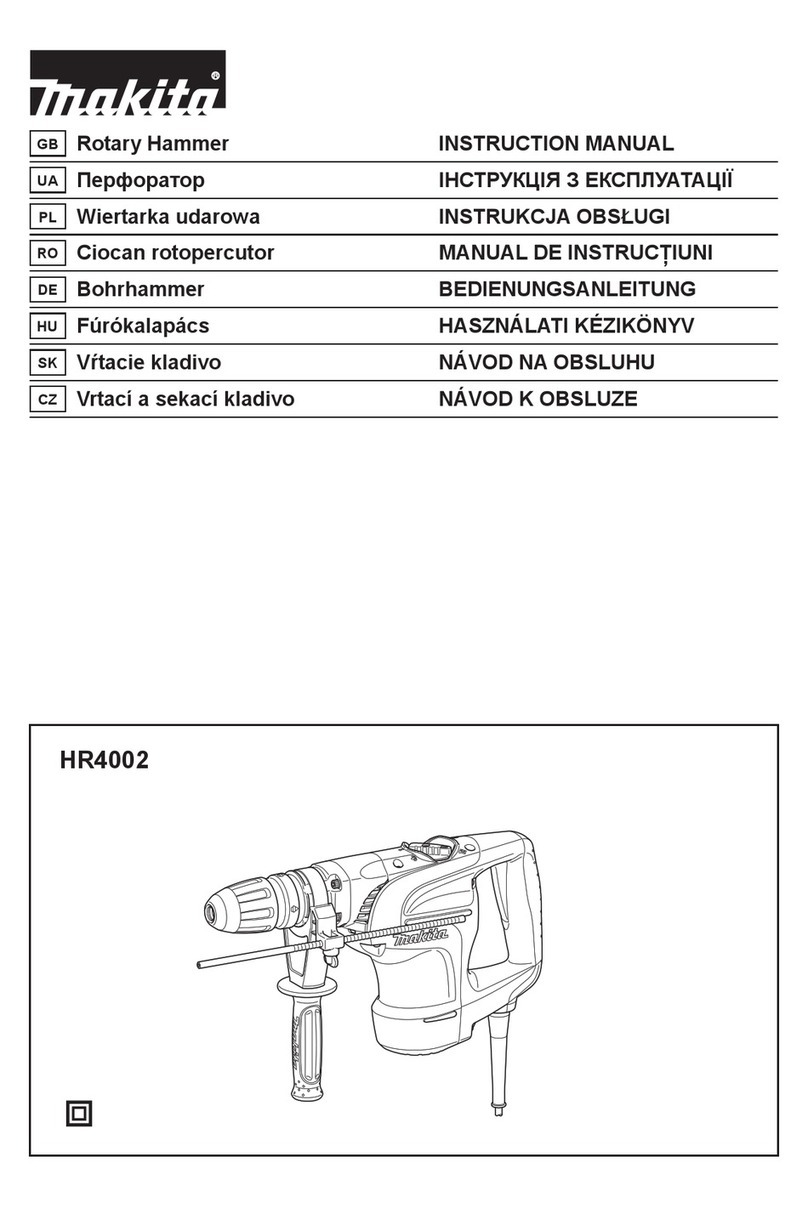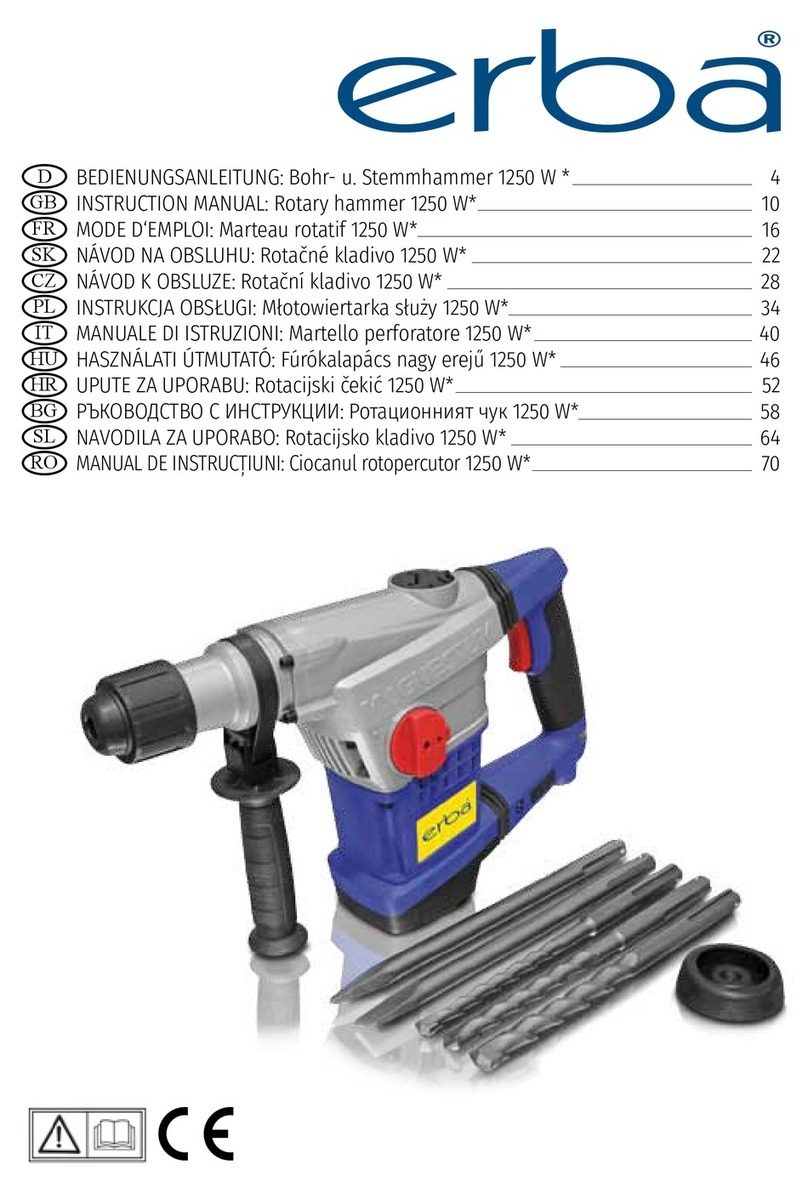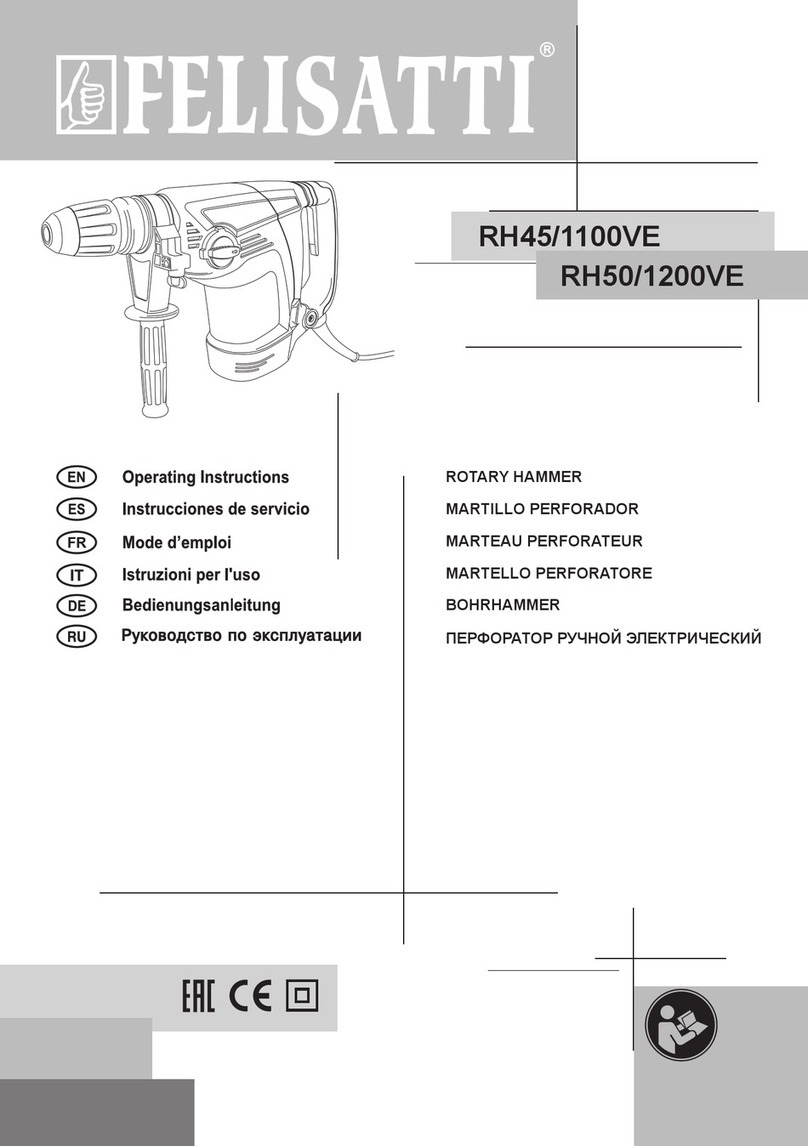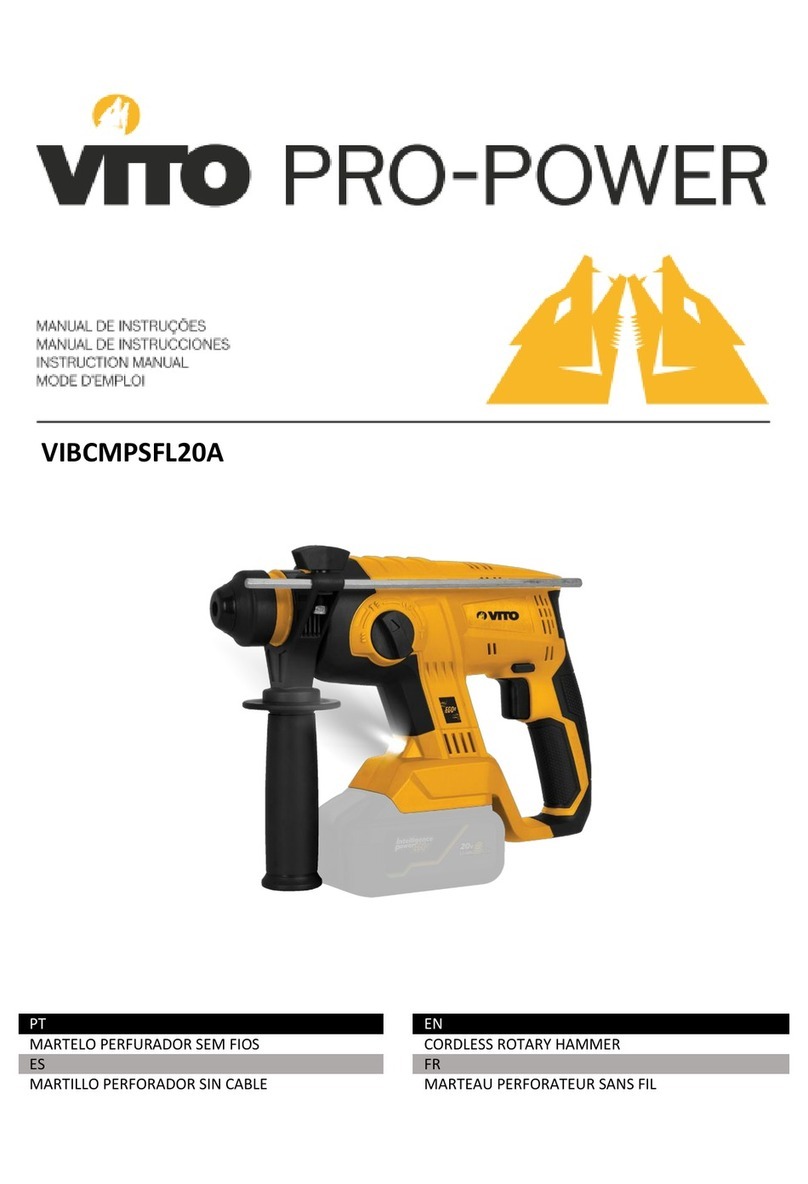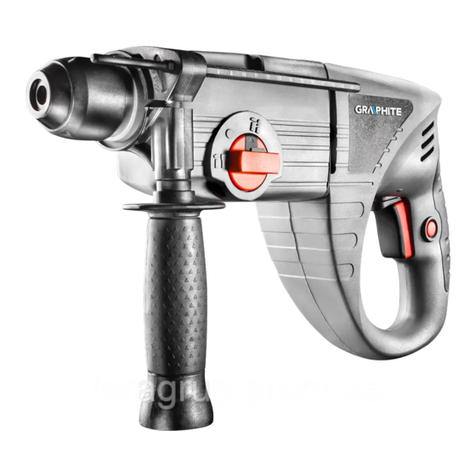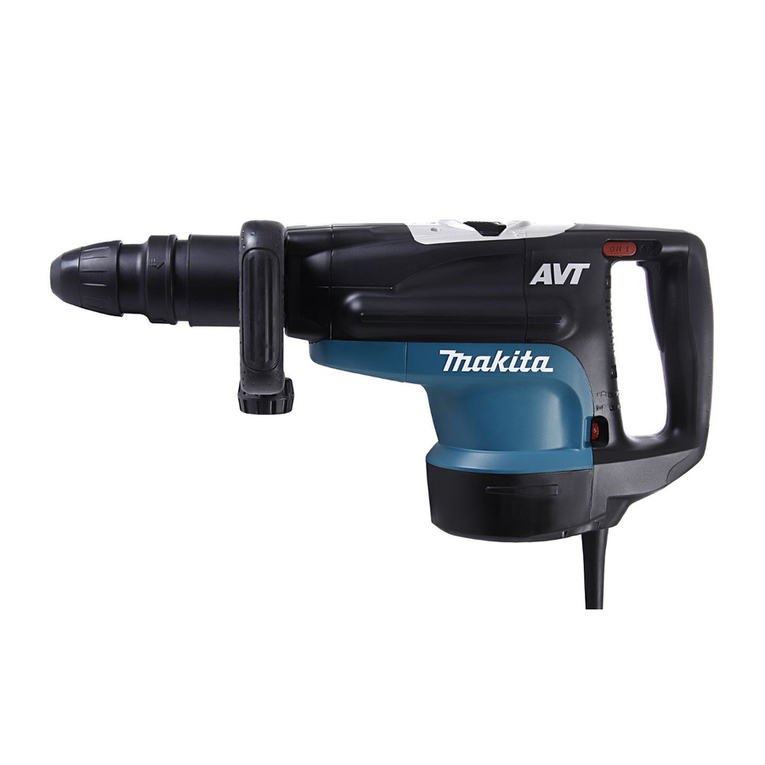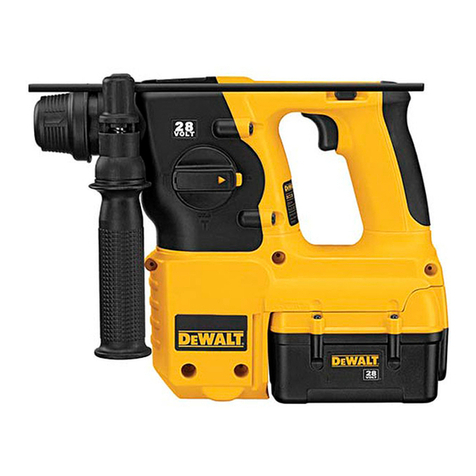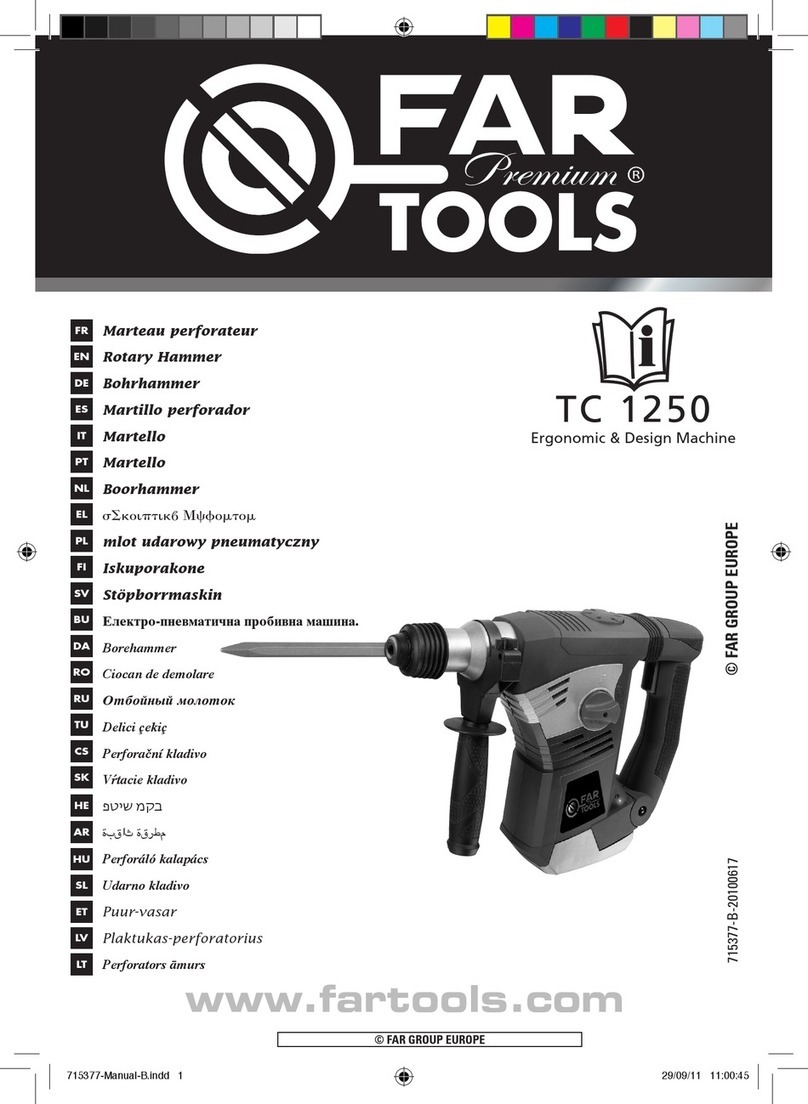SPIT 383 SVC User manual

de Originalbetriebsanleitung . . . . . . . . . . . . . . . . . . . . . . . . . . . . . . . Seite 3
en Original instructions. . . . . . . . . . . . . . . . . . . . . . . . . . . . . . . . . . . . . Page 8
fr Notice originale. . . . . . . . . . . . . . . . . . . . . . . . . . . . . . . . Page 14
es Manual original . . . . . . . . . . . . . . . . . . . . . . . . . . . . . . Página 20
pt Manual original . . . . . . . . . . . . . . . . . . . . . . . . . . . . . . Página 27
it Istruzioni originali . . . . . . . . . . . . . . . . . . . . . . . . . . . . Pagina 33
nl Oorspronkelijke gebruiksaanwijzing . . . . . . . . . . . . . . Pagina 39
da Original brugsanvisning . . . . . . . . . . . . . . . . . . . . . . . . . Side 45
fi Alkuperäiset ohjeet . . . . . . . . . . . . . . . . . . . . . . . . . . . . . Sivu 51
el Πρωτότυπο οδηγιών χρήσης . . . . . . . . . . . . . . . . . . . . Σελίδα 57
pl Instrukcja oryginalna. . . . . . . . . . . . . . . . . . . . . . . . . . Strona 64
cs Původní návod k používání . . . . . . . . . . . . . . . . . . . . . . Strana 71
ar . . . . . . . . . . . . . . . . . . . . . . . . . . 82
ςТЎϩХʉ ЌТϾϦφЍʉ ʌμВТЎϺυ
OBJ_BUCH-2829-001.book Page 1 Wednesday, April 6, 2016 3:07 PM

Deutsch | 2
1 609 92A 2KR • 6.4.16
Deutsch
Allgemeine Sicherheitshinweise
für Elektrowerkzeuge
Lesen Sie alle Sicherheitshinweise
und Anweisungen. Versäumnisse
bei der Einhaltung der Sicherheitshinweise und An-
weisungen können elektrischen Schlag, Brand
und/oder schwere Verletzungen verursachen.
Bewahren Sie alle Sicherheitshinweise und Anwei-
sungen für die Zukunft auf.
Der in den Sicherheitshinweisen verwendete Begriff
„Elektrowerkzeug“ bezieht sich auf netzbetriebene
Elektrowerkzeuge (mit Netzkabel) und auf akkubetrie-
bene Elektrowerkzeuge (ohne Netzkabel).
Arbeitsplatzsicherheit
Halten Sie Ihren Arbeitsbereich sauber und gut
beleuchtet. Unordnung oder unbeleuchtete Ar-
beitsbereiche können zu Unfällen führen.
Arbeiten Sie mit dem Elektrowerkzeug nicht in
explosionsgefährdeter Umgebung, in der sich
brennbare Flüssigkeiten, Gase oder Stäube be-
finden. Elektrowerkzeuge erzeugen Funken, die
den Staub oder die Dämpfe entzünden können.
Halten Sie Kinder und andere Personen wäh-
rend der Benutzung des Elektrowerkzeugs fern.
Bei Ablenkung können Sie die Kontrolle über das
Gerät verlieren.
Elektrische Sicherheit
Der Anschlussstecker des Elektrowerkzeuges
muss in die Steckdose passen. Der Stecker darf
in keiner Weise verändert werden. Verwenden
Sie keine Adapterstecker gemeinsam mit
schutzgeerdeten Elektrowerkzeugen. Unverän-
derte Stecker und passende Steckdosen verrin-
gern das Risiko eines elektrischen Schlages.
Vermeiden Sie Körperkontakt mit geerdeten
Oberflächen wie von Rohren, Heizungen, Her-
den und Kühlschränken. Es besteht ein erhöhtes
Risiko durch elektrischen Schlag, wenn Ihr Körper
geerdet ist.
Halten Sie Elektrowerkzeuge von Regen oder
Nässe fern. Das Eindringen von Wasser in ein
Elektrowerkzeug erhöht das Risiko eines elektri-
schen Schlages.
Zweckentfremden Sie das Kabel nicht, um das
Elektrowerkzeug zu tragen, aufzuhängen oder
um den Stecker aus der Steckdose zu ziehen.
Halten Sie das Kabel fern von Hitze, Öl, scharfen
Kanten oder sich bewegenden Geräteteilen. Be-
schädigte oder verwickelte Kabel erhöhen das Ri-
siko eines elektrischen Schlages.
Wenn Sie mit einem Elektrowerkzeug im Freien
arbeiten, verwenden Sie nur Verlängerungska-
bel, die auch für den Außenbereich geeignet
sind. Die Anwendung eines für den Außenbereich
geeigneten Verlängerungskabels verringert das Ri-
siko eines elektrischen Schlages.
Wenn der Betrieb des Elektrowerkzeuges in
feuchter Umgebung nicht vermeidbar ist, ver-
wenden Sie einen Fehlerstromschutzschalter.
Der Einsatz eines Fehlerstromschutzschalters ver-
mindert das Risiko eines elektrischen Schlages.
Sicherheit von Personen
Seien Sie aufmerksam, achten Sie darauf, was
Sie tun, und gehen Sie mit Vernunft an die Arbeit
mit einem Elektrowerkzeug. Benutzen Sie kein
Elektrowerkzeug, wenn Sie müde sind oder un-
ter dem Einfluss von Drogen, Alkohol oder Medi-
kamenten stehen. Ein Moment der Unachtsam-
keit beim Gebrauch des Elektrowerkzeuges kann
zu ernsthaften Verletzungen führen.
Tragen Sie persönliche Schutzausrüstung und
immer eine Schutzbrille. Das Tragen persönlicher
Schutzausrüstung, wie Staubmaske, rutschfeste
Sicherheitsschuhe, Schutzhelm oder Gehör-
schutz, je nach Art und Einsatz des Elektrowerk-
zeuges, verringert das Risiko von Verletzungen.
Vermeiden Sie eine unbeabsichtigte Inbetrieb-
nahme. Vergewissern Sie sich, dass das Elektro-
werkzeug ausgeschaltet ist, bevor Sie es an die
Stromversorgung und/oder den Akku anschlie-
ßen, es aufnehmen oder tragen. Wenn Sie beim
Tragen des Elektrowerkzeuges den Finger am
Schalter haben oder das Gerät eingeschaltet an
die Stromversorgung anschließen, kann dies zu
Unfällen führen.
Entfernen Sie Einstellwerkzeuge oder Schrau-
benschlüssel, bevor Sie das Elektrowerkzeug
einschalten. Ein Werkzeug oder Schlüssel, der
sich in einem drehenden Geräteteil befindet, kann
zu Verletzungen führen.
Vermeiden Sie eine abnormale Körperhaltung.
Sorgen Sie für einen sicheren Stand und halten
Sie jederzeit das Gleichgewicht. Dadurch kön-
nen Sie das Elektrowerkzeug in unerwarteten Situ-
ationen besser kontrollieren.
Tragen Sie geeignete Kleidung. Tragen Sie kei-
ne weite Kleidung oder Schmuck. Halten Sie
Haare, Kleidung und Handschuhe fern von sich
WARNUNG
OBJ_BUCH-2829-001.book Page 2 Wednesday, April 6, 2016 3:07 PM

Deutsch | 3
1 609 92A 2KR • 6.4.16
bewegenden Teilen. Lockere Kleidung, Schmuck
oder lange Haare können von sich bewegenden
Teilen erfasst werden.
Wenn Staubabsaug- und -auffangeinrichtungen
montiert werden können, vergewissern Sie sich,
dass diese angeschlossen sind und richtig ver-
wendet werden. Verwendung einer Staubabsau-
gung kann Gefährdungen durch Staub verringern.
Verwendung und Behandlung des
Elektrowerkzeuges
Überlasten Sie das Gerät nicht. Verwenden Sie
für Ihre Arbeit das dafür bestimmte Elektrowerk-
zeug. Mit dem passenden Elektrowerkzeug arbei-
ten Sie besser und sicherer im angegebenen Leis-
tungsbereich.
Benutzen Sie kein Elektrowerkzeug, dessen
Schalter defekt ist. Ein Elektrowerkzeug, das sich
nicht mehr ein- oder ausschalten lässt, ist gefähr-
lich und muss repariert werden.
Ziehen Sie den Stecker aus der Steckdose
und/oder entfernen Sie den Akku, bevor Sie Ge-
räteeinstellungen vornehmen, Zubehörteile
wechseln oder das Gerät weglegen. Diese Vor-
sichtsmaßnahme verhindert den unbeabsichtigten
Start des Elektrowerkzeuges.
Bewahren Sie unbenutzte Elektrowerkzeuge au-
ßerhalb der Reichweite von Kindern auf. Lassen
Sie Personen das Gerät nicht benutzen, die mit
diesem nicht vertraut sind oder diese Anweisun-
gen nicht gelesen haben. Elektrowerkzeuge sind
gefährlich, wenn sie von unerfahrenen Personen
benutzt werden.
Pflegen Sie Elektrowerkzeuge mit Sorgfalt. Kon-
trollieren Sie, ob bewegliche Teile einwandfrei
funktionieren und nicht klemmen, ob Teile ge-
brochen oder so beschädigt sind, dass die Funk-
tion des Elektrowerkzeuges beeinträchtigt ist.
Lassen Sie beschädigte Teile vor dem Einsatz
des Gerätes reparieren. Viele Unfälle haben ihre
Ursache in schlecht gewarteten Elektrowerkzeu-
gen.
Halten Sie Schneidwerkzeuge scharf und sau-
ber. Sorgfältig gepflegte Schneidwerkzeuge mit
scharfen Schneidkanten verklemmen sich weniger
und sind leichter zu führen.
Verwenden Sie Elektrowerkzeug, Zubehör, Ein-
satzwerkzeuge usw. entsprechend diesen An-
weisungen. Berücksichtigen Sie dabei die Ar-
beitsbedingungen und die auszuführende
Tätigkeit. Der Gebrauch von Elektrowerkzeugen
für andere als die vorgesehenen Anwendungen
kann zu gefährlichen Situationen führen.
Service
Lassen Sie Ihr Elektrowerkzeug nur von qualifi-
ziertem Fachpersonal und nur mit Original-Er-
satzteilen reparieren. Damit wird sichergestellt,
dass die Sicherheit des Elektrowerkzeuges erhal-
ten bleibt.
Sicherheitshinweise für Hämmer
Tragen Sie Gehörschutz. Die Einwirkung von Lärm
kann Gehörverlust bewirken.
Benutzen Sie Zusatzgriffe, wenn diese mit dem
Elektrowerkzeug mitgeliefert werden. Der Verlust
der Kontrolle kann zu Verletzungen führen.
Halten Sie das Gerät an den isolierten Griffflä-
chen, wenn Sie Arbeiten ausführen, bei denen
das Einsatzwerkzeug verborgene Stromleitun-
gen oder das eigene Netzkabel treffen kann. Der
Kontakt mit einer spannungsführenden Leitung
kann auch metallene Geräteteile unter Spannung
setzen und zu einem elektrischen Schlag führen.
Weitere Sicherheits- und
Arbeitshinweise
Beachten Sie die Netzspannung! Die Spannung
der Stromquelle muss mit den Angaben auf dem
Typenschild des Elektrowerkzeuges überein-
stimmen.
Verwenden Sie geeignete Suchgeräte, um ver-
borgene Versorgungsleitungen aufzuspüren,
oder ziehen Sie die örtliche Versorgungsgesell-
schaft hinzu. Kontakt mit Elektroleitungen kann zu
Feuer und elektrischem Schlag führen. Beschädi-
gung einer Gasleitung kann zur Explosion führen.
Eindringen in eine Wasserleitung verursacht Sach-
beschädigung.
Ziehen Sie den Zusatzhandgriff fest an, halten
Sie das Elektrowerkzeug beim Arbeiten fest mit
beiden Händen und sorgen Sie für einen sicheren
Stand. Das Elektrowerkzeug wird mit zwei Händen
sicher geführt.
Wählen Sie für das Material, das Sie bearbeiten
wollen, die richtige Betriebsart und das geeigne-
te Einsatzwerkzeug.
SDS-max-Einsatzwerkzeug einsetzen: Überprü-
fen Sie die Verriegelung durch Ziehen am Werk-
zeug.
Lassen Sie eine beschädigte Staubschutzkappe
sofort ersetzen. Die Staubschutzkappe verhindert
weitgehend das Eindringen von Bohrstaub in die
OBJ_BUCH-2829-001.book Page 3 Wednesday, April 6, 2016 3:07 PM

Deutsch | 4
1 609 92A 2KR • 6.4.16
Werkzeugaufnahme während des Betriebes. Ach-
ten Sie beim Einsetzen des Werkzeuges darauf,
dass die Staubschutzkappe nicht beschädigt wird.
Stäube von Materialien wie bleihaltigem An-
strich, einigen Holzarten, Mineralien und Metall
können gesundheitsschädlich sein und zu aller-
gischen Reaktionen, Atemwegserkrankungen
und/oder Krebs führen. Asbesthaltiges Material
darf nur von Fachleuten bearbeitet werden.
–Benutzen Sie möglichst eine für das Material ge-
eignete Staubabsaugung.
–Sorgen Sie für gute Belüftung des Arbeitsplat-
zes.
–Es wird empfohlen, eine Atemschutzmaske mit
Filterklasse P2 zu tragen.
Beachten Sie in Ihrem Land gültige Vorschriften für
die zu bearbeitenden Materialien.
Sollte das Einsatzwerkzeug blockieren, schalten
Sie das Elektrowerkzeug aus. Lösen Sie das Ein-
satzwerkzeug.
Überzeugen Sie sich vor dem Einschalten des
Elektrowerkzeugs von der Freigängigkeit des
Einsatzwerkzeugs. Beim Einschalten mit einem
blockierten Bohrwerkzeug entstehen hohe Reakti-
onsmomente.
Um Energie zu sparen, schalten Sie das Elektro-
werkzeug nur ein, wenn Sie es benutzen.
Warten Sie, bis das Elektrowerkzeug zum Still-
stand gekommen ist, bevor Sie es ablegen. Das
Einsatzwerkzeug kann sich verhaken und zum Ver-
lust der Kontrolle über das Elektrowerkzeug führen.
Wiederanlaufschutz
Der Wiederanlaufschutz verhindert im Meißel-
betrieb das unkontrollierte Anlaufen des Elektro-
werkzeuges nach einer Unterbrechung der Strom-
zufuhr.
–Zur Wiederinbetriebnahme bringen Sie den
Ein-/Ausschalter in die ausgeschaltete Position
und schalten das Elektrowerkzeug erneut ein.
Symbole
Die nachfolgenden Symbole sind für das Lesen und
Verstehen der Betriebsanleitung von Bedeutung. Prä-
gen Sie sich die Symbole und ihre Bedeutung ein. Die
richtige Interpretation der Symbole hilft Ihnen, das
Elektrowerkzeug besser und sicherer zu gebrauchen.
Vibrationsdämpfung
Die integrierte Vibrationsdämpfung reduziert auf-
tretende Vibrationen.
Symbol Bedeutung
SPIT 383 SVC:
Bohrhammer
grau markierter Bereich: Hand-
griff (isolierte Grifffläche)
Sachnummer
Lesen Sie alle Sicherheitshinwei-
se und Anweisungen
Ziehen Sie vor allen Arbeiten am
Elektrowerkzeug den Netzstecker
aus der Steckdose
Tragen Sie Schutzhandschuhe
Tragen Sie Gehörschutz.
Tragen Sie eine Schutzbrille
Bewegungsrichtung
Reaktionsrichtung
Nächster Handlungsschritt
Verbotene Handlung
Hammerbohren
Meißeln
Vario-Lock
Einschalten
Ausschalten
XXXXXX
OBJ_BUCH-2829-001.book Page 4 Wednesday, April 6, 2016 3:07 PM

Deutsch | 5
1 609 92A 2KR • 6.4.16
Lieferumfang
Bohrhammer, Zusatzhandgriff.
Einsatzwerkzeug und weiteres abgebildetes oder be-
schriebenes Zubehör gehören nicht zum Standard-
Lieferumfang.
Das vollständige Zubehör finden Sie in unserem Zube-
hörprogramm.
Bestimmungsgemäßer Gebrauch
Das Elektrowerkzeug ist bestimmt zum Hammerboh-
ren in Beton, Ziegel und Gestein sowie für Meißelar-
beiten.
Technische Daten
Die Technischen Daten des Produkts sind in der Ta-
belle auf Seite 83 angegeben.
Die Angaben gelten für eine Nennspannung [U] von
230 V. Bei abweichenden Spannungen und in länder-
spezifischen Ausführungen können diese Angaben
variieren.
Konformitätserklärung
Wir erklären in alleiniger Verantwortung, dass das un-
ter „Technische Daten“ beschriebene Produkt allen
einschlägigen Bestimmungen der Richtlinien
2011/65/EU, bis 19. April 2016: 2004/108/EG, ab
20. April 2016: 2014/30/EU, 2006/42/EG einschließ-
lich ihrer Änderungen entspricht und mit folgenden
Normen übereinstimmt: EN 60745-1, EN 60745-2-6.
Technische Unterlagen (2006/42/EG) bei:
SPIT SAS, 150 Route de Lyon BP104,
2501 Bourg-Lès-Valence Cedex, FRANCE
Jean-Michel DREVETON
SPIT Quality Manager
Operations Valence
SPIT SAS; 150, Route de Lyon;
26500 Bourg-lès-Valence Cedex
FRANCE
08.04.2016
Geräusch-/Vibrationsinformation
Die Messwerte des Produkts sind in der Tabelle auf
Seite 83 angegeben.
Geräuschemissionswerte ermittelt entsprechend
EN 60745-2-6.
Schwingungsgesamtwerte ah(Vektorsumme dreier
Richtungen) und Unsicherheit K ermittelt entspre-
chend EN 60745-2-6.
Ein-/Ausschalter feststellen
Ein-/Ausschalter entriegeln
Kleine Dreh-/Schlagzahl
Große Dreh-/Schlagzahl
Werkzeugaufnahme
Fetten Sie das Einsteckende des
Einsatzwerkzeugs leicht ein
Service-Anzeige
P1Nennaufnahmeleistung
E Einzelschlagstärke entsprechend
EPTA-Procedure 05/2009
n0Leerlaufdrehzahl
Wiederanlaufschutz
ØBohrdurchmesser max.
Beton
Mauerwerk
Wendelbohrer
Durchbruchbohrer
Hohlbohrkrone
Gewicht entsprechend
EPTA-Procedure 01:2014
Schutzklasse
LwA Schallleistungspegel
LpA Schalldruckpegel
ahSchwingungsgesamtwert
KUnsicherheit
Symbol Bedeutung
OBJ_BUCH-2829-001.book Page 5 Wednesday, April 6, 2016 3:07 PM

Deutsch | 6
1 609 92A 2KR • 6.4.16
Der in diesen Anweisungen angegebene Schwin-
gungspegel ist entsprechend einem in EN 60745 ge-
normten Messverfahren gemessen worden und kann
für den Vergleich von Elektrowerkzeugen miteinander
verwendet werden. Er eignet sich auch für eine vorläu-
fige Einschätzung der Schwingungsbelastung.
Der angegebene Schwingungspegel repräsentiert die
hauptsächlichen Anwendungen des Elektrowerk-
zeugs. Wenn allerdings das Elektrowerkzeug für ande-
re Anwendungen, mit unterschiedlichen Zubehören,
mit abweichenden Einsatzwerkzeugen oder ungenü-
gender Wartung eingesetzt wird, kann der Schwin-
gungspegel abweichen. Dies kann die Schwingungs-
belastung über den gesamten Arbeitszeitraum
deutlich erhöhen.
Für eine genaue Abschätzung der Schwingungsbelas-
tung sollten auch die Zeiten berücksichtigt werden, in
denen das Gerät abgeschaltet ist oder zwar läuft, aber
nicht tatsächlich im Einsatz ist. Dies kann die Schwin-
gungsbelastung über den gesamten Arbeitszeitraum
deutlich reduzieren.
Legen Sie zusätzliche Sicherheitsmaßnahmen zum
Schutz des Bedieners vor der Wirkung von Schwin-
gungen fest wie zum Beispiel: Wartung von Elektro-
werkzeug und Einsatzwerkzeugen, Warmhalten der
Hände, Organisation der Arbeitsabläufe.
Montage und Betrieb
Die folgende Tabelle zeigt die Handlungsziele für Montage und Betrieb des Elektrowerkzeugs. Die Anweisungen
der Handlungsziele werden im angegebenen Bild gezeigt. Je nach Art der Anwendung sind unterschiedliche
Kombinationen der Anweisungen erforderlich. Beachten Sie die Sicherheitshinweise.
Handlungsziel Bild Beachten Sie Seite
SDS-max-Einsatzwerkzeug
einsetzen
184
SDS-max-Einsatzwerkzeug
entnehmen
284
Betriebsart wählen 385
Meißelstellung verändern
(Vario-Lock)
485
Zusatzgriff schwenken 585
Ein-/Ausschalten im Bohrbe-
trieb
686
OBJ_BUCH-2829-001.book Page 6 Wednesday, April 6, 2016 3:07 PM

Deutsch | 7
1 609 92A 2KR • 6.4.16
Wartung und Reinigung
Halten Sie das Elektrowerkzeug und die Lüftungs-
schlitze sauber, um gut und sicher zu arbeiten.
Wenn ein Ersatz der Anschlussleitung erforderlich ist,
dann ist dies von SPIT oder einer autorisierten Kun-
dendienststelle für SPIT-Elektrowerkzeuge auszufüh-
ren, um Sicherheitsgefährdungen zu vermeiden.
Service-Anzeige
(siehe Bild 9, Seite 87)
Bei verbrauchten Schleifkohlen schaltet das Elektro-
werkzeug selbsttätig ab. Dies wird ca. 8 Stunden vor-
her durch Aufleuchten oder Flackern der Service-An-
zeige angezeigt. Das Elektrowerkzeug muss zur
Wartung an den Kundendienst geschickt werden.
Wenn die Service-Anzeige in regelmäßigen Abstän-
den blinkt, ist das Elektrowerkzeug defekt. Verwen-
den Sie in diesem Fall das Elektrowerkzeug nicht wei-
ter und schicken Sie es sofort an den Kundendienst.
Kundendienst und Anwendungs-
beratung
Der Kundendienst beantwortet Ihre Fragen zu Repara-
tur und Wartung Ihres Produkts sowie zu Ersatzteilen.
Explosionszeichnungen und Informationen zu Ersatz-
teilen finden Sie auch unter:
www.spit.com
Geben Sie bei allen Rückfragen und Ersatzteilbestel-
lungen bitte unbedingt die 6-stellige Sachnummer laut
Typenschild des Elektrowerkzeuges an.
Entsorgung
Elektrowerkzeuge, Zubehör und Verpackungen sollen
einer umweltgerechten Wiederverwertung zugeführt
werden.
Werfen Sie Elektrowerkzeuge nicht in den Hausmüll!
Nur für EU-Länder:
Gemäß der Europäischen Richtlinie
2012/19/EU über Elektro- und Elektro-
nik-Altgeräte und ihrer Umsetzung in
nationales Recht müssen nicht mehr
gebrauchsfähige Elektrowerkzeuge
getrennt gesammelt und einer umwelt-
gerechten Wiederverwertung zugeführt werden.
Änderungen vorbehalten.
Ein-/Ausschalten im Meißel-
betrieb
786
Drehzahl einstellen 886
Service-Anzeige beachten 987
Handlungsziel Bild Beachten Sie Seite
OBJ_BUCH-2829-001.book Page 7 Wednesday, April 6, 2016 3:07 PM

English | 8
1 609 92A 2KR • 6.4.16
English
General Power Tool Safety Warn-
ings
Read all safety warnings and all in-
structions. Failure to follow the warn-
ings and instructions may result in electric shock, fire
and/or serious injury.
Save all warnings and instructions for future refer-
ence.
The term “power tool” in the warnings refers to your
mains-operated (corded) power tool or battery-operat-
ed (cordless) power tool.
Work area safety
Keep work area clean and well lit. Cluttered or
dark areas invite accidents.
Do not operate power tools in explosive atmos-
pheres, such as in the presence of flammable
liquids, gases or dust. Power tools create sparks
which may ignite the dust or fumes.
Keep children and bystanders away while oper-
ating a power tool. Distractions can cause you to
lose control.
Electrical safety
Power tool plugs must match the outlet. Never
modify the plug in any way. Do not use any
adapter plugs with earthed (grounded) power
tools. Unmodified plugs and matching outlets will
reduce risk of electric shock.
Avoid body contact with earthed or grounded
surfaces, such as pipes, radiators, ranges and
refrigerators. There is an increased risk of electric
shock if your body is earthed or grounded.
Do not expose power tools to rain or wet condi-
tions. Water entering a power tool will increase the
risk of electric shock.
Do not abuse the cord. Never use the cord for
carrying, pulling or unplugging the power tool.
Keep cord away from heat, oil, sharp edges and
moving parts. Damaged or entangled cords in-
crease the risk of electric shock.
When operating a power tool outdoors, use an
extension cord suitable for outdoor use. Use of a
cord suitable for outdoor use reduces the risk of
electric shock.
If operating a power tool in a damp location is
unavoidable, use a residual current device
(RCD) protected supply. Use of an RCD reduces
the risk of electric shock.
Personal safety
Stay alert, watch what you are doing and use
common sense when operating a power tool. Do
not use a power tool while you are tired or under
the influence of drugs, alcohol or medication. A
moment of inattention while operating power tools
may result in serious personal injury.
Use personal protective equipment. Always
wear eye protection. Protective equipment such
as dust mask, non-skid safety shoes, hard hat, or
hearing protection used for appropriate conditions
will reduce personal injuries.
Prevent unintentional starting. Ensure the
switch is in the off-position before connecting to
power source and/or battery pack, picking up or
carrying the tool. Carrying power tools with your
finger on the switch or energising power tools that
have the switch on invites accidents.
Remove any adjusting key or wrench before
turning the power tool on. A wrench or a key left
attached to a rotating part of the power tool may
result in personal injury.
Do not overreach. Keep proper footing and bal-
ance at all times. This enables better control of
the power tool in unexpected situations.
Dress properly. Do not wear loose clothing or
jewellery. Keep your hair, clothing and gloves
away from moving parts. Loose clothes, jewellery
or long hair can be caught in moving parts.
If devices are provided for the connection of
dust extraction and collection facilities, ensure
these are connected and properly used. Use of
dust collection can reduce dust-related hazards.
Power tool use and care
Do not force the power tool. Use the correct
power tool for your application. The correct pow-
er tool will do the job better and safer at the rate for
which it was designed.
Do not use the power tool if the switch does not
turn it on and off. Any power tool that cannot be
controlled with the switch is dangerous and must
be repaired.
Disconnect the plug from the power source
and/or the battery pack from the power tool be-
fore making any adjustments, changing acces-
sories, or storing power tools. Such preventive
safety measures reduce the risk of starting the
power tool accidentally.
WARNING
OBJ_BUCH-2829-001.book Page 8 Wednesday, April 6, 2016 3:07 PM

English | 9
1 609 92A 2KR • 6.4.16
Store idle power tools out of the reach of chil-
dren and do not allow persons unfamiliar with
the power tool or these instructions to operate
the power tool. Power tools are dangerous in the
hands of untrained users.
Maintain power tools. Check for misalignment
or binding of moving parts, breakage of parts
and any other condition that may affect the pow-
er tool’s operation. If damaged, have the power
tool repaired before use. Many accidents are
caused by poorly maintained power tools.
Keep cutting tools sharp and clean. Properly
maintained cutting tools with sharp cutting edges
are less likely to bind and are easier to control.
Use the power tool, accessories and tool bits
etc. in accordance with these instructions, tak-
ing into account the working conditions and the
work to be performed. Use of the power tool for
operations different from those intended could re-
sult in a hazardous situation.
Service
Have your power tool serviced by a qualified re-
pair person using only identical replacement
parts. This will ensure that the safety of the power
tool is maintained.
Hammer Safety Warnings
Wear ear protectors. Exposure to noise can cause
hearing loss.
Use auxiliary handle(s), if supplied with the tool.
Loss of control can cause personal injury.
Hold power tool by insulated gripping surfaces,
when performing an operation where the cutting
accessory may contact hidden wiring or its own
cord. Cutting accessory contacting a “live” wire
may make exposed metal parts of the power tool
“live” and could give the operator an electric shock.
Products sold in GB only: Your product is fitted
with a BS 1363/A approved electric plug with inter-
nal fuse (ASTA approved to BS 1362).
If the plug is not suitable for your socket outlets, it
should be cut off and an appropriate plug fitted in
its place by an authorised customer service agent.
The replacement plug should have the same fuse
rating as the original plug.
The severed plug must be disposed of to avoid a
possible shock hazard and should never be insert-
ed into a mains socket elsewhere.
Products sold in AUS and NZ only: Use a residual
current device (RCD) with a rated residual current
of 30 mA or less.
Additional Safety and Working In-
structions
Observe the mains voltage! The voltage of the
power source must correspond with the data on
the type plate of the machine.
Use appropriate detectors to determine if utility
lines are hidden in the work area or call the local
utility company for assistance. Contact with elec-
tric lines can lead to fire and electric shock. Damag-
ing a gas line can lead to explosion. Penetrating a
water line causes property damage.
Firmly tighten the auxiliary handle, hold the ma-
chine firmly with both hands while working and
keep proper footing and balance at all times. The
machine is securely guided with both hands.
Select the correct operating mode and the suita-
ble application tool for the material to be worked.
Insert the SDS-max application tool: Check the
latching by pulling the tool.
Replace a damaged dust protection cap immedi-
ately. The dust protection cap largely prevents the
penetration of drilling dust into the tool holder dur-
ing operation. When inserting the tool, pay atten-
tion that the dust protection cap is not damaged.
Dust from materials such as lead-containing
coatings, some wood types, minerals and metal
can be harmful to one’s health and cause allergic
reactions, lead to respiratory infections and/or
cancer. Materials containing asbestos may only be
worked by specialists.
–As far as possible, use a dust extraction system
suitable for the material.
–Provide for good ventilation of the working
place.
–It is recommended to wear a P2 filter-class res-
pirator.
Observe the relevant regulations in your country for
the materials to be worked.
If the application tool should become blocked,
switch the machine off. Loosen the application
tool.
Before switching on the power tool, make sure
that the application tool moves freely. When
switching on with a blocked drilling tool, high
torque reaction can occur.
To save energy, only switch the power tool on when
using it.
Always wait until the machine has come to a com-
plete stop before placing it down. The tool insert
can jam and lead to loss of control over the power
tool.
OBJ_BUCH-2829-001.book Page 9 Wednesday, April 6, 2016 3:07 PM

English | 10
1 609 92A 2KR • 6.4.16
Restarting Protection
In chiselling mode, the restarting protection pre-
vents uncontrolled starting of the machine after a
power failure.
–To restart the operation, switch the On/Off
switch to the Off position and start the machine
again.
Symbols
The following symbols are important for reading and
understanding the operating instructions. Please take
note of the symbols and their meaning. The correct in-
terpretation of the symbols will help you to use the ma-
chine in a better and safer manner.
Vibration Damper
The integrated vibration damper reduces occur-
ring vibrations.
Symbol Meaning
SPIT 383 SVC: Rotary Hammer
Grey-marked area: Handle
(insulated gripping surface)
Article number
Read all safety warnings and all
instructions
Before any work on the machine
itself, pull the mains plug from the
socket outlet
Wear protective gloves
Always wear ear protection.
Wear safety glasses/goggles
Movement direction
XXXXXX
Reaction direction
Next step of action
Prohibited action
Hammer Drilling
Chiselling
Vario-Lock
Switching On
Switching Off
On/Off switch lock-on
Releasing the On/Off switch
Low speed/impact rate
High speed/impact rate
Tool holder
Apply a light coat of grease to the
shank end of the application tool
Service Indicator
P1Rated power input
E Impact energy per stroke accord-
ing to EPTA-Procedure 05/2009
n0No-load speed
Restarting Protection
ØDrilling diameter, max.
Concrete
Symbol Meaning
OBJ_BUCH-2829-001.book Page 10 Wednesday, April 6, 2016 3:07 PM

English | 11
1 609 92A 2KR • 6.4.16
Delivery Scope
Rotary hammer, auxiliary handle.
Application tools and other accessories shown or de-
scribed are not part of the standard delivery scope.
A complete overview of accessories can be found in
our accessories program.
Intended Use
The machine is intended for hammer drilling in con-
crete, brick and stone as well as for chiselling.
Technical Data
The technical data of the machine are listed in the ta-
ble on page 83.
The values given are valid for a nominal voltage [U] of
230 V. For different voltages and models for specific
countries, these values can vary.
Declaration of Conformity
We declare under our sole responsibility that the prod-
uct described under “Technical Data” is in conformity
with all relevant provisions of the directives
2011/65/EU, until 19 April 2016: 2004/108/EC, from
20 April 2016 on: 2014/30/EU, 2006/42/EC including
their amendments and complies with the following
standards: EN 60745-1, EN 60745-2-6.
Technical file (2006/42/EC) at:
SPIT SAS, 150 Route de Lyon BP104,
2501 Bourg-Lès-Valence Cedex, FRANCE
Jean-Michel DREVETON
SPIT Quality Manager
Operations Valence
SPIT SAS; 150, Route de Lyon;
26500 Bourg-lès-Valence Cedex
FRANCE
08.04.2016
Noise/Vibration Information
The measured values of the machine are listed in the
table on page 83.
Sound emission values determined according to
EN 60745-2-6.
Vibration total values ah(triax vector sum) and uncer-
tainty K determined according to EN 60745-2-6.
The vibration level given in this information sheet has
been measured in accordance with a standardised
test given in EN 60745 and may be used to compare
one tool with another. It may be used for a preliminary
assessment of exposure.
The declared vibration emission level represents the
main applications of the tool. However if the tool is
used for different applications, with different accesso-
ries or insertion tools or is poorly maintained, the vi-
bration emission may differ. This may significantly in-
crease the exposure level over the total working
period.
An estimation of the level of exposure to vibration
should also take into account the times when the tool
is switched off or when it is running but not actually
doing the job. This may significantly reduce the expo-
sure level over the total working period.
Identify additional safety measures to protect the op-
erator from the effects of vibration such as: maintain
the tool and the accessories, keep the hands warm,
organisation of work patterns.
Brickwork
Twist drill bit
Break-through drill bit
Core bit
Weight according to
EPTA-Procedure 01:2014
Protection class
LwA Sound power level
LpA Sound pressure level
ahVibration total value
K Uncertainty
Symbol Meaning
OBJ_BUCH-2829-001.book Page 11 Wednesday, April 6, 2016 3:07 PM

English | 12
1 609 92A 2KR • 6.4.16
Mounting and Operation
The following table indicates the action objectives for mounting and operation of the power tool. The instruc-
tions for each action objective are shown aside. Depending on the type of application, various instruction com-
binations are required. Observe the safety instructions.
Action Figure Please observe Page
Insert the SDS-max applica-
tion tool
184
Removing the SDS-max
application tool
284
Selecting the Operating Mode 385
Changing the chisel position
(Vario-Lock)
485
Changing the position of the
auxiliary handle
585
Switching On/Off in Drilling
Mode
686
Switching On/Off in Chiselling
Mode
786
Adjusting the Speed 886
Observing the service
indicator
987
OBJ_BUCH-2829-001.book Page 12 Wednesday, April 6, 2016 3:07 PM

English | 13
1 609 92A 2KR • 6.4.16
Maintenance and Cleaning
For safe and proper working, always keep the
machine and ventilation slots clean.
If the replacement of the supply cord is necessary, this
has to be done by SPIT or an authorised SPIT service
agent in order to avoid a safety hazard.
Service Indicator
(see Fig. 9, page 87)
When the carbon brushes are worn out, the machine
switches itself off. This is indicated approx. 8 hours
beforehand by the lighting or blinking of the service in-
dicator . The machine must then be sent to an after-
sales service agent.
Service indicator flashes in regular intervals, the ma-
chine is defective. In this case, do not continue to use
the machine and send it immediately to an after-sales
service agent.
After-sales Service and Applica-
tion Service
Our after-sales service responds to your questions
concerning maintenance and repair of your product
as well as spare parts. Exploded views and informa-
tion on spare parts can also be found under:
www.spit.com
In all correspondence and spare parts order, please
always include the 6-digit article number given on the
type plate of the machine.
Disposal
The machine, accessories and packaging should be
sorted for environmental-friendly recycling.
Do not dispose of power tools into household waste!
Only for EC countries:
According to the European Guideline
2012/19/EU for Waste Electrical and
Electronic Equipment and its imple-
mentation into national right, power
tools that are no longer usable must be
collected separately and disposed of
in an environmentally correct manner.
Subject to change without notice.
OBJ_BUCH-2829-001.book Page 13 Wednesday, April 6, 2016 3:07 PM

Français | 14
1 609 92A 2KR • 6.4.16
Français
Avertissements de sécurité géné-
raux pour l’outil
Lire tous les avertisse-
ments de sécurité et toutes
les instructions. Ne pas suivre les avertissements et
instructions peut donner lieu à un choc électrique, un
incendie et/ou une blessure sérieuse.
Conserver tous les avertissements et toutes les ins-
tructions pour pouvoir s’y reporter ultérieurement.
Le terme « outil » dans les avertissements fait réfé-
rence à votre outil électrique alimenté par le secteur
(avec cordon d’alimentation) ou votre outil fonction-
nant sur batterie (sans cordon d’alimentation).
Sécurité de la zone de travail
Conserver la zone de travail propre et bien éclai-
rée. Les zones en désordre ou sombres sont pro-
pices aux accidents.
Ne pas faire fonctionner les outils électriques en
atmosphère explosive, par exemple en présence
de liquides inflammables, de gaz ou de pous-
sières. Les outils électriques produisent des étin-
celles qui peuvent enflammer les poussières ou les
fumées.
Maintenir les enfants et les personnes pré-
sentes à l’écart pendant l’utilisation de l’outil.
Les distractions peuvent vous faire perdre le
contrôle de l’outil.
Sécurité électrique
Il faut que les fiches de l’outil électrique soient
adaptées au socle. Ne jamais modifier la fiche
de quelque façon que ce soit. Ne pas utiliser
d’adaptateurs avec des outils à branchement de
terre. Des fiches non modifiées et des socles
adaptés réduiront le risque de choc électrique.
Eviter tout contact du corps avec des surfaces
reliées à la terre telles que les tuyaux, les radia-
teurs, les cuisinières et les réfrigérateurs. Il
existe un risque accru de choc électrique si votre
corps est relié à la terre.
Ne pas exposer les outils à la pluie ou à des
conditions humides. La pénétration d’eau à l’inté-
rieur d’un outil augmentera le risque de choc élec-
trique.
Ne pas maltraiter le cordon. Ne jamais utiliser le
cordon pour porter, tirer ou débrancher l’outil.
Maintenir le cordon à l’écart de la chaleur, du lu-
brifiant, des arêtes ou des parties en mouve-
ment. Les cordons endommagés ou emmêlés
augmentent le risque de choc électrique.
Lorsqu’on utilise un outil à l’extérieur, utiliser un
prolongateur adapté à l’utilisation extérieure.
L’utilisation d’un cordon adapté à l’utilisation exté-
rieure réduit le risque de choc électrique.
Si l’usage d’un outil dans un emplacement hu-
mide est inévitable, utiliser une alimentation
protégée par un dispositif à courant différentiel
résiduel (RCD). L’usage d’un RCD réduit le risque
de choc électrique.
Sécurité des personnes
Rester vigilant, regarder ce que vous êtes en
train de faire et faire preuve de bon sens dans
l’utilisation de l’outil. Ne pas utiliser un outil
lorsque vous êtes fatigué ou sous l’emprise de
drogues, d’alcool ou de médicaments. Un mo-
ment d’inattention en cours d’utilisation d’un outil
peut entraîner des blessures graves des per-
sonnes.
Utiliser un équipement de sécurité. Toujours
porter une protection pour les yeux. Les équipe-
ments de sécurité tels que les masques contre les
poussières, les chaussures de sécurité antidéra-
pantes, les casques ou les protections acous-
tiques utilisés pour les conditions appropriées ré-
duiront les blessures des personnes.
Eviter tout démarrage intempestif. S’assurer
que l’interrupteur est en position arrêt avant de
brancher l’outil au secteur et/ou au bloc de bat-
teries, de le ramasser ou de le porter. Porter les
outils en ayant le doigt sur l’interrupteur ou bran-
cher des outils dont l’interrupteur est en position
marche est source d’accidents.
Retirer toute clé de réglage avant de mettre l’ou-
til en marche. Une clé laissée fixée sur une partie
tournante de l’outil peut donner lieu à des bles-
sures de personnes.
Ne pas se précipiter. Garder une position et un
équilibre adaptés à tout moment. Cela permet un
meilleur contrôle de l’outil dans des situations inat-
tendues.
S’habiller de manière adaptée. Ne pas porter de
vêtements amples ou de bijoux. Garder les che-
veux, les vêtements et les gants à distance des
parties en mouvement. Des vêtements amples,
des bijoux ou les cheveux longs peuvent être pris
dans des parties en mouvement.
Si des dispositifs sont fournis pour le raccorde-
ment d’équipements pour l’extraction et la récu-
pération des poussières, s’assurer qu’ils sont
AVERTISSEMENT
OBJ_BUCH-2829-001.book Page 14 Wednesday, April 6, 2016 3:07 PM

Français | 15
1 609 92A 2KR • 6.4.16
connectés et correctement utilisés. Utiliser des
collecteurs de poussière peut réduire les risques
dus aux poussières.
Utilisation et entretien de l’outil
Ne pas forcer l’outil. Utiliser l’outil adapté à votre
application. L’outil adapté réalisera mieux le tra-
vail et de manière plus sûre au régime pour lequel
il a été construit.
Ne pas utiliser l’outil si l’interrupteur ne permet
pas de passer de l’état de marche à arrêt et vice
versa. Tout outil qui ne peut pas être commandé
par l’interrupteur est dangereux et il faut le faire ré-
parer.
Débrancher la fiche de la source d’alimentation
en courant et/ou le bloc de batteries de l’outil
avant tout réglage, changement d’accessoires
ou avant de ranger l’outil. De telles mesures de
sécurité préventives réduisent le risque de démar-
rage accidentel de l’outil.
Conserver les outils à l’arrêt hors de la portée
des enfants et ne pas permettre à des per-
sonnes ne connaissant pas l’outil ou les pré-
sentes instructions de le faire fonctionner. Les
outils sont dangereux entre les mains d’utilisateurs
novices.
Observer la maintenance de l’outil. Vérifier qu’il
n’y a pas de mauvais alignement ou de blocage
des parties mobiles, des pièces cassées ou
toute autre condition pouvant affecter le fonc-
tionnement de l’outil. En cas de dommages,
faire réparer l’outil avant de l’utiliser. De nom-
breux accidents sont dus à des outils mal entrete-
nus.
Garder affûtés et propres les outils permettant
de couper. Des outils destinés à couper correcte-
ment entretenus avec des pièces coupantes tran-
chantes sont moins susceptibles de bloquer et
sont plus faciles à contrôler.
Utiliser l’outil, les accessoires et les lames etc.,
conformément à ces instructions, en tenant
compte des conditions de travail et du travail à
réaliser. L’utilisation de l’outil pour des opérations
différentes de celles prévues pourrait donner lieu
à des situations dangereuses.
Maintenance et entretien
Faire entretenir l’outil par un réparateur qualifié
utilisant uniquement des pièces de rechange
identiques. Cela assurera que la sécurité de l’outil
est maintenue.
Avertissements de sécurité pour
les marteaux
Portez des protections auditives. L’exposition aux
bruits peut provoquer une perte de l’audition.
Utiliser la(les) poignée(s) auxiliaire(s) fournie(s)
avec l’outil. La perte de contrôle peut provoquer
des blessures.
Tenir l’outil par les surfaces de préhension iso-
lées, lors de la réalisation d’une opération au
cours de laquelle l’organe de coupe peut entrer
en contact avec un câblage non apparent ou son
propre cordon d’alimentation. Le contact avec un
fil « sous tension » peut également mettre « sous
tension » les parties métalliques exposées de l’outil
électrique et provoquer un choc électrique sur
l’opérateur.
Autres instructions de sécurité et
d’utilisation
Tenez compte de la tension du réseau ! La ten-
sion de la source d’alimentation électrique doit
correspondre aux indications se trouvant sur la
plaque signalétique de l’outil électroportatif.
Utiliser des détecteurs appropriés afin de déce-
ler des conduites cachées ou consulter les entre-
prises d’approvisionnement locales. Un contact
avec des conduites d’électricité peut provoquer un
incendie ou un choc électrique. Un endommage-
ment d’une conduite de gaz peut provoquer une ex-
plosion. La perforation d’une conduite d’eau pro-
voque des dégâts matériels.
Serrez la poignée supplémentaire, tenez l’outil
électrique fermement des deux mains lors du tra-
vail et veillez à toujours garder une position de
travail stable. Avec les deux mains, l’outil électro-
portatif est guidé en toute sécurité.
Sélectionnez le mode de travail adapté et l’outil
de travail approprié pour le matériau à travailler.
Mettez un outil de travail SDS-max en place: Véri-
fiez si l’outil est bien encliqueté en tirant sur ce der-
nier.
Faire immédiatement remplacer un capot anti-
poussière endommagé. Le capot anti-poussière
empêche dans une large mesure la pénétration de
poussière dans le porte-outil pendant le fonctionne-
ment de l’appareil. Lors du montage de l’outil, veil-
lez à ne pas endommager le capot anti-poussière.
Les poussières de matières comme les peintures
contenant du plomb, certaines essences de bois,
certains minéraux ou métaux peuvent être nui-
sibles à la santé et peuvent causer des réactions
OBJ_BUCH-2829-001.book Page 15 Wednesday, April 6, 2016 3:07 PM

Français | 16
1 609 92A 2KR • 6.4.16
allergiques, des maladies des voies respiratoires
et/ou un cancer. Les matériaux contenant de
l’amiante ne doivent être travaillés que par des per-
sonnes qualifiées.
–Si possible, utilisez un dispositif d’aspiration
des poussières approprié au matériau.
–Veillez à bien aérer la zone de travail.
–Il est recommandé de porter un masque respira-
toire avec un niveau de filtration de classe P2.
Respectez les règlements spécifiques aux maté-
riaux à traiter en vigueur dans votre pays.
Au cas où l’outil de travail serait bloqué, arrêtez
l’outil électroportatif. Desserrez l’outil de travail.
Avant de mettre en marche l’outil électroportatif,
s’assurer que l’outil de travail puisse librement
bouger. Lorsqu’on met l’appareil en marche, l’outil
de travail étant bloqué, il peut y avoir de fortes réac-
tions.
Afin d’économiser l’énergie, ne mettez l’outil élec-
troportatif en marche que quand vous l’utilisez.
Avant de déposer l’outil électroportatif, attendre
que celui-ci soit complètement à l’arrêt. L’outil
risque de se coincer, ce qui entraînerait une perte
de contrôle de l’outil électroportatif.
Protection contre un démarrage intempestif
En mode burinage, le dispositif de protection
contre un démarrage intempestif évite le démar-
rage incontrôlé de l’outil électroportatif après une
interruption de l’alimentation en courant.
–Afin de remettre l’appareil en service, mettez
l’interrupteur Marche/Arrêt en position d’arrêt
et remettez l’outil électroportatif en marche.
Symboles
Les symboles suivants sont importants pour pouvoir
lire et mieux comprendre le mode d’emploi. Veuillez
mémoriser ces symboles et leur signification. L’inter-
prétation correcte des symboles vous permettra de
mieux utiliser votre outil électroportatif en toute sécu-
rité.
Dispositif d’amortissement des vibrations
Le dispositif intégré pour l’amortissement des vi-
brations réduit les vibrations se produisant lors du
travail.
Symbole Signification
SPIT 383 SVC:
Marteau perforateur
Partie marquée en gris : poignée
(surface de préhension isolante)
N° d’article
Toutes les consignes de sécurité
et toutes les instructions doivent
être lues
Avant d’effectuer des travaux sur
l’outil électroportatif, retirez la
fiche de la prise de courant
Portez des gants de protection
Portez une protection acoustique.
Portez des lunettes de protection
Direction de déplacement
Direction de réaction
Prochaine action
Interdit
Perçage à percussion
Burinage
Vario-Lock
Mise en marche
Arrêt
XXXXXX
OBJ_BUCH-2829-001.book Page 16 Wednesday, April 6, 2016 3:07 PM

Français | 17
1 609 92A 2KR • 6.4.16
Accessoires fournis
Marteau perforateur, poignée supplémentaire.
L’outil de travail et d’autres accessoires décrits ou il-
lustrés ne sont pas tous compris dans la fourniture.
Vous trouverez les accessoires complets dans notre
programme d’accessoires.
Utilisation conforme
L’appareil est conçu pour des travaux de perçage en
frappe dans le béton, la brique et la pierre ainsi que
pour des travaux de burinage.
Caractéristiques techniques
Les caractéristiques techniques du produit sont indi-
quées dans le tableau à la page 83.
Ces indications sont valables pour une tension nomi-
nale de [U] 230 V. Ces indications peuvent varier pour
des tensions plus basses ainsi que pour des versions
spécifiques à certains pays.
Déclaration de conformité
Nous déclarons sous notre propre responsabilité que
le produit décrit sous « Caractéristiques techniques »
est en conformité avec toutes les dispositions des di-
rectives 2011/65/UE, 2004/108/CE (jusqu’au
19 avril 2016), 2014/30/UE (à partir du 20 avril 2016),
2006/42/CE et leurs modifications ainsi qu’avec les
normes suivantes : EN 60745-1, EN 60745-2-6.
Dossier technique (2006/42/CE) auprès de :
SPIT SAS, 150 Route de Lyon BP104,
2501 Bourg-Lès-Valence Cedex, FRANCE
Jean-Michel DREVETON
SPIT Quality Manager
Operations Valence
SPIT SAS; 150, Route de Lyon;
26500 Bourg-lès-Valence Cedex
FRANCE
08.04.2016
Niveau sonore et vibrations
Les valeurs de mesure du produit sont indiquées dans
le tableau à la page 83.
Valeurs d’émissions sonores déterminées selon la
norme EN 60745-2-6.
Valeurs totales des vibrations ah(somme vectorielle
des trois axes directionnels) et incertitude K relevées
conformément à la norme EN 60745-2-6.
Verrouiller l’interrupteur
Marche/Arrêt
Déverrouillage de l’interrupteur
Marche/Arrêt
Vitesse de rotation/fréquence de
frappe faible
Vitesse de rotation/fréquence de
frappe élevée
Porte-outil
Graissez légèrement l’emman-
chement de l’outil de travail
Affichage service
P1Puissance nominale absorbée
E Puissance de frappe individuelle
suivant EPTA-Procedure 05/2009
n0Vitesse à vide
Protection contre un démarrage
intempestif
ØDiamètre max. de perçage
Béton
Maçonnerie
Foret hélicoïdal
Foret hélicoïdal à multi-taillants
Couronne trépans
Poids suivant
EPTA-Procedure 01:2014
Classe de protection
LwA Niveau d’intensité acoustique
LpA Niveau de pression acoustique
ahValeurs totales des vibrations
KIncertitude
Symbole Signification
OBJ_BUCH-2829-001.book Page 17 Wednesday, April 6, 2016 3:07 PM

Français | 18
1 609 92A 2KR • 6.4.16
Le niveau d’oscillation indiqué dans ces instructions
d’utilisation a été mesuré conformément à la norme
EN 60745 et peut être utilisé pour une comparaison
d’outils électroportatifs. Il est également approprié
pour une estimation préliminaire de la charge vibra-
toire.
Le niveau d’oscillation correspond aux utilisations
principales de l’outil électroportatif. Si l’outil élec-
trique est néanmoins utilisé pour d’autres applica-
tions, avec différents accessoires ou d’autres outils de
travail ou s’il est mal entretenu, le niveau d’oscillation
peut être différent. Ceci peut augmenter considéra-
blement la charge vibratoire pendant toute la durée de
travail.
Pour une estimation précise de la charge vibratoire, il
est recommandé de prendre aussi en considération
les périodes pendant lesquelles l’appareil est éteint
ou en fonctionnement, mais pas vraiment utilisé. Ceci
peut réduire considérablement la charge vibratoire
pendant toute la durée de travail.
Déterminez des mesures de protection supplémen-
taires pour protéger l’utilisateur des effets des vibra-
tions, telles que par exemple : Entretien de l’outil élec-
trique et des outils de travail, maintenir les mains
chaudes, organisation des opérations de travail.
Montage et mise en service
Le tableau ci-après indique les modes opératoires pour le montage et l’utilisation de l’outil électroportatif. Les
instructions spécifiques aux modes opératoires sont illustrées dans la figure correspondante. En fonction de
l’utilisation, différents types d’instructions sont nécessaires. Tenez compte des consignes de sécurité !
Opération Figure Respectez Page
Mettez un outil de travail
SDS-max en place
184
Retirer un outil de travail
SDS-max
284
Sélection du mode de
fonctionnement
385
Modification de la position
du burin (Vario-Lock)
485
Pivoter la poignée
supplémentaire
585
Mise en fonctionnement/Arrêt
en mode de perçage
686
OBJ_BUCH-2829-001.book Page 18 Wednesday, April 6, 2016 3:07 PM

Français | 19
1 609 92A 2KR • 6.4.16
Nettoyage et entretien
Veillez à ce que l’outil électroportatif ainsi que les
ouïes de ventilation soient toujours propres afin
d’obtenir un travail impeccable et sûr.
Dans le cas où un remplacement de la fiche de raccor-
dement s’avère nécessaire, ceci ne doit être effectué
que par SPIT ou un point de Service Après-Vente
agréé pour outillage SPIT afin d’éviter des dangers de
sécurité.
Affichage service
(voir figure 9, page 87)
Lorsque les balais sont usés, l’appareil électroportatif
s’arrête automatiquement. Ceci est indiqué environ 8
heures auparavant par l’allumage ou le clignotement
de l’affichage service . L’appareil électroportatif doit
être envoyé auprès d’un service après-vente pour y
faire effectuer les travaux d’entretien.
Si l’affichage service clignote régulièrement, c’est que
l’outil électroportatif est défectueux. Si tel est le cas,
ne continuez pas à utiliser l’outil électroportatif et
faites-le parvenir aussitôt à une station de Service
Après-Vente.
Service Après-Vente et Assis-
tance
Notre Service Après-Vente répond à vos questions
concernant la réparation et l’entretien de votre produit
et les pièces de rechange. Vous trouverez des vues
éclatées ainsi que des informations concernant les
pièces de rechange également sous :
www.spit.com
Pour toute demande de renseignement ou com-
mande de pièces de rechange, précisez-nous impéra-
tivement le numéro d’article à 6 chiffres indiqué sur la
plaque signalétique de l’outil électroportatif.
Élimination des déchets
Les outils électroportatifs, ainsi que leurs accessoires
et emballages, doivent pouvoir suivre chacun une voie
de recyclage appropriée.
Ne jetez pas les outils électroportatifs avec les ordures
ménagères !
Seulement pour les pays de l’Union Européenne :
Conformément à la directive euro-
péenne 2012/19/UE relative aux dé-
chets d’équipements électriques et
électroniques et sa mise en vigueur
conformément aux législations natio-
nales, les outils électroportatifs dont
on ne peut plus se servir doivent être isolés et suivre
une voie de recyclage appropriée.
Sous réserve de modifications.
Mise en fonctionnement/Arrêt
en mode de burinage
786
Réglage de la vitesse de
rotation
886
Respecter l’affichage service 987
Opération Figure Respectez Page
OBJ_BUCH-2829-001.book Page 19 Wednesday, April 6, 2016 3:07 PM

Español | 20
1 609 92A 2KR • 6.4.16
Español
Advertencias de peligro genera-
les para herramientas eléctricas
Lea íntegramente estas adver-
tencias de peligro e instruc-
ciones. En caso de no atenerse a las advertencias de
peligro e instrucciones siguientes, ello puede ocasio-
nar una descarga eléctrica, un incendio y/o lesión gra-
ve.
Guardar todas las advertencias de peligro e instruc-
ciones para futuras consultas.
El término herramienta eléctrica empleado en las si-
guientes advertencias de peligro se refiere a herra-
mientas eléctricas de conexión a la red (con cable de
red) y a herramientas eléctricas accionadas por acu-
mulador (o sea, sin cable de red).
Seguridad del puesto de trabajo
Mantenga limpio y bien iluminado su puesto de
trabajo. El desorden o una iluminación deficiente
en las áreas de trabajo pueden provocar acciden-
tes.
No utilice la herramienta eléctrica en un entorno
con peligro de explosión, en el que se encuen-
tren combustibles líquidos, gases o material en
polvo. Las herramientas eléctricas producen chis-
pas que pueden llegar a inflamar los materiales en
polvo o vapores.
Mantenga alejados a los niños y otras personas
de su puesto de trabajo al emplear la herramien-
ta eléctrica. Una distracción le puede hacer per-
der el control sobre la herramienta eléctrica.
Seguridad eléctrica
El enchufe de la herramienta eléctrica debe co-
rresponder a la toma de corriente utilizada. No
es admisible modificar el enchufe en forma algu-
na. No emplear adaptadores en herramientas
eléctricas dotadas con una toma de tierra. Los
enchufes sin modificar adecuados a las respecti-
vas tomas de corriente reducen el riesgo de una
descarga eléctrica.
Evite que su cuerpo toque partes conectadas a
tierra como tuberías, radiadores, cocinas y refri-
geradores. El riesgo a quedar expuesto a una sa-
cudida eléctrica es mayor si su cuerpo tiene con-
tacto con tierra.
No exponga la herramienta eléctrica a la lluvia y
evite que penetren líquidos en su interior. Existe
el peligro de recibir una descarga eléctrica si pe-
netran ciertos líquidos en la herramienta eléctrica.
No utilice el cable de red para transportar o col-
gar la herramienta eléctrica, ni tire de él para sa-
car el enchufe de la toma de corriente. Manten-
ga el cable de red alejado del calor, aceite,
esquinas cortantes o piezas móviles. Los cables
de red dañados o enredados pueden provocar una
descarga eléctrica.
Al trabajar con la herramienta eléctrica a la in-
temperie utilice solamente cables de prolonga-
ción apropiados para su uso en exteriores. La
utilización de un cable de prolongación adecuado
para su uso en exteriores reduce el riesgo de una
descarga eléctrica.
Si fuese imprescindible utilizar la herramienta
eléctrica en un entorno húmedo, es necesario
conectarla a través de un fusible diferencial. La
aplicación de un fusible diferencial reduce el ries-
go a exponerse a una descarga eléctrica.
Seguridad de personas
Esté atento a lo que hace y emplee la herramien-
ta eléctrica con prudencia. No utilice la herra-
mienta eléctrica si estuviese cansado, ni tampo-
co después de haber consumido alcohol, drogas
o medicamentos. El no estar atento durante el uso
de la herramienta eléctrica puede provocarle se-
rias lesiones.
Utilice un equipo de protección personal y en to-
do caso unas gafas de protección. El riesgo a le-
sionarse se reduce considerablemente si, depen-
diendo del tipo y la aplicación de la herramienta
eléctrica empleada, se utiliza un equipo de protec-
ción adecuado como una mascarilla antipolvo, za-
patos de seguridad con suela antideslizante, cas-
co, o protectores auditivos.
Evite una puesta en marcha fortuita. Asegurarse
de que la herramienta eléctrica esté desconec-
tada antes de conectarla a la toma de corriente
y/o al montar el acumulador, al recogerla, y al
transportarla. Si transporta la herramienta eléctri-
ca sujetándola por el interruptor de conexión/des-
conexión, o si alimenta la herramienta eléctrica es-
tando ésta conectada, ello puede dar lugar a un
accidente.
Retire las herramientas de ajuste o llaves fijas
antes de conectar la herramienta eléctrica. Una
herramienta de ajuste o llave fija colocada en una
pieza rotante puede producir lesiones al poner a
funcionar la herramienta eléctrica.
Evite posturas arriesgadas. Trabaje sobre una
base firme y mantenga el equilibrio en todo mo-
ADVERTENCIA
OBJ_BUCH-2829-001.book Page 20 Wednesday, April 6, 2016 3:07 PM
Table of contents
Languages:
Other SPIT Rotary Hammer manuals
